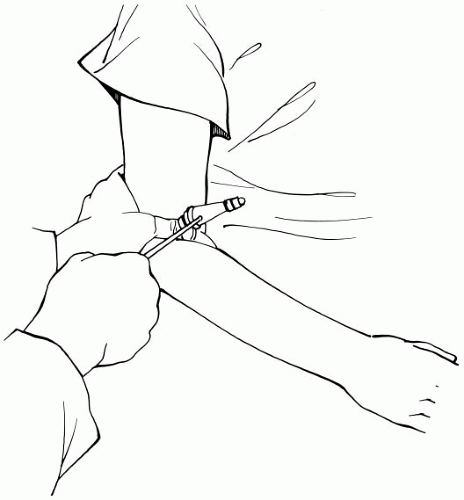Examination of the Muscle Stretch Reflexes
PURPOSE
The purpose of testing muscle stretch reflexes is to localize neurologic pathology to the central or the peripheral nervous system by looking for evidence of upper motor neuron or lower motor neuron (or peripheral sensory nerve) dysfunction.
WHEN TO TEST THE MUSCLE STRETCH REFLEXES
Muscle stretch reflexes in the biceps, triceps, knees, and ankles should be examined in all patients as part of a routine neurologic examination. Testing for clonus in the ankles should be performed when hyperreflexia is seen in the lower extremities.
NEUROANATOMY OF THE MUSCLE STRETCH REFLEXES
The muscle spindles are sensory organs located within the muscles that sense muscle stretch (lengthening). Tapping a tendon with a reflex hammer causes a sudden muscle stretch that activates the muscle spindles. The muscle spindles send a sensory impulse to the spinal cord, which then synapses with motor neurons at that level of the spinal cord to initiate reflex contraction of the same muscle that was stretched. For example, tapping the left quadriceps tendon at the knee stretches the left quadriceps muscle (and its muscle spindles), initiating reflex contraction of the left quadriceps muscle, which is observed clinically as extension of the knee. The corticospinal tract—the upper motor neuron—has an inhibitory influence on the muscle stretch reflexes in the spinal cord.
EQUIPMENT NEEDED TO TEST THE MUSCLE STRETCH REFLEXES
A reflex hammer.
Any kind of reflex hammer will do, but reflexes are easier to obtain with a heavier hammer than the typical lightweight, tomahawk-style reflex hammer. Many neurologists prefer the Queen Square type of hammer, which consists of a rubber-rimmed disc on the end of a stick. Others, including the author, prefer a Tromner-style hammer, which is more “hammer-like” than the Queen Square hammer or the tomahawk. All reflex hammers are fairly inexpensive; go to a medical bookstore and pick out a hammer that you’ll actually carry around and that works well for you.
HOW TO EXAMINE THE MUSCLE STRETCH REFLEXES
Routine Testing of Muscle Stretch Reflexes
It is easiest to test the reflexes with the patient sitting on the side of a bed or an examining table; however, the muscle stretch reflexes can also be tested with the patient lying in bed.
Test the upper extremity reflexes before testing the lower extremity reflexes. It’s also best to check the same reflex on each side before proceeding to the next muscle. In other words, start by testing the right biceps jerk, then test the left biceps jerk, then test the right triceps jerk, the left triceps jerk, and so forth.
Figures 37-1, 37-2, 37-3 and 37-4 illustrate and describe how to examine the major muscle stretch reflexes in the upper and lower extremities. Hold each limb in the optimal position for reflex testing for that muscle, as indicated in the figures. It’s important to have the patient’s limb as relaxed as possible (simply asking the patient to relax the muscle often helps).
Grade the reflex on a scale of 0 to 4, with 0 meaning the reflex is unobtainable and 4 meaning it is severely hyperreflexic. Table 37-1 summarizes the definition of the grading scale used for muscle stretch reflex testing. It is standard to report the grade as the number with a plus sign after it. The plus has no real meaning, but it is standard to write it that way. If you want, you can write the number without the plus, because there is no distinction between a 2, for example, and a 2+. Unlike muscle strength grading, a minus signs tends not to be used, so think of the reflex choices as only five grades (from 0 to 4), and choose the one grade that seems to fit best. Some clinicians prefer one more choice, however, between 0 and 1, called trace, meaning that there may be a suggestion of a slight reflex present, enough not to call it areflexic.
 Figure 37-1 Testing the biceps reflex. Hold the patient’s arm so that it is passively flexed and that your thumb is resting on the biceps tendon. Tap on your thumb with the reflex hammer. |
Testing Reflexes with Reinforcement
When a reflex seems unobtainable or is much diminished, it may be because the patient’s muscle was not relaxed and the patient is inadvertently suppressing the reflex. In this situation, it is useful to try to distract the patient from the reflex task; this may bring out the reflex if it is really intact and is called reinforcement of the reflex. Several maneuvers are helpful to do this: One method of distraction is simply to ask the patient to “bite down” at the time you test the reflex; another maneuver is to ask the patient to make a tight fist with the opposite hand while you test the upper extremity reflex on the other side.
Stay updated, free articles. Join our Telegram channel

Full access? Get Clinical Tree




